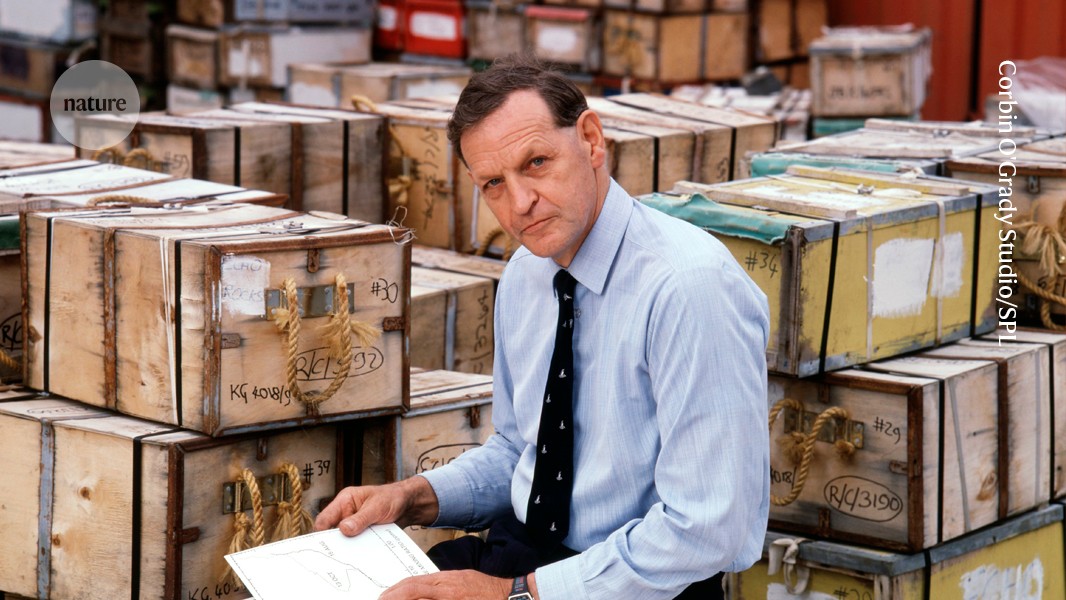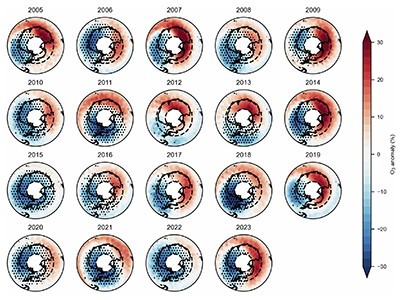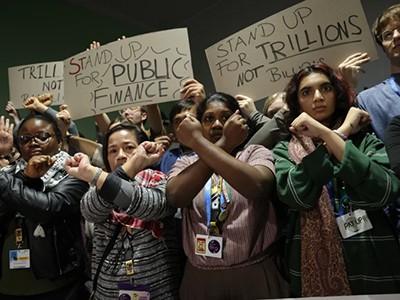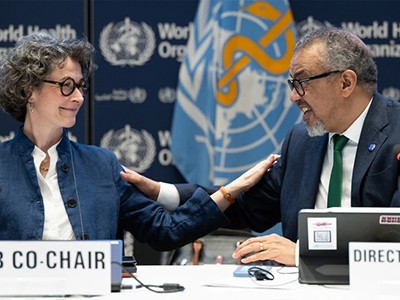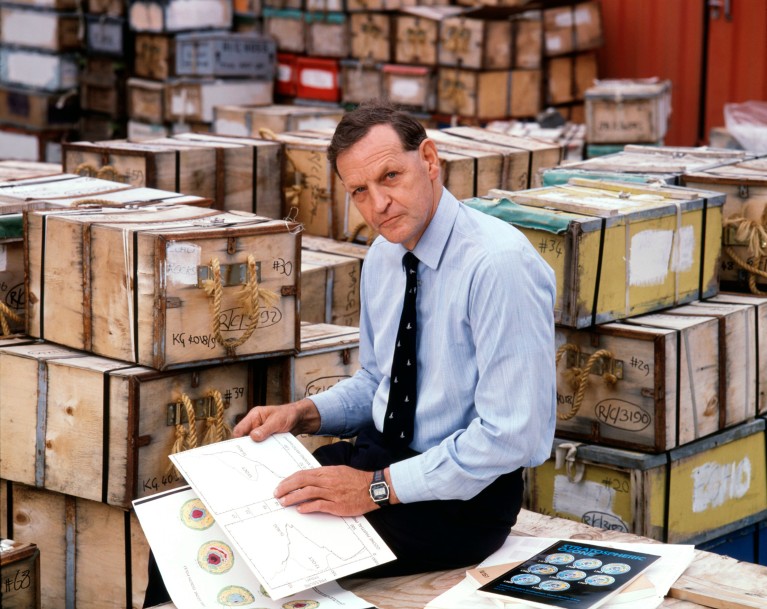
Many scientists thought ozone depletion to be a long-term problem. Research by Joe Farman (pictured in 1989) and his colleagues showed otherwise.Credit: Corbin O’Grady Studio/Science Photo Library
In May 1985, scientists reported the first evidence of a substantial loss of ozone high in the atmosphere above Antarctica. Concern had been growing for more than a decade that a class of fluorinated chemicals used in everything from spray cans to solvents to refrigerators might be harming the stratospheric ozone layer, which is some 15–30 kilometres above Earth’s surface and filters out a large amount of harmful ultraviolet radiation from the Sun. At the time, many scientists thought that ozone depletion was a long-term problem that would unfold over the coming century. However, a group at the British Antarctic Survey in Cambridge, UK, led by geophysicist Joe Farman, showed that a hole had already appeared1.
The shock of this revelation led to a swift global effort and the creation of one of history’s most successful environmental treaties, the Montreal Protocol. Policymakers and researchers should revisit how that success was achieved in a world that was, as it is today, sharply divided.
Fingerprinting the recovery of Antarctic ozone
In 1974, the chemists Mario Molina and Sherwood Rowland had highlighted the perils of chlorofluorocarbons (CFCs) for stratospheric ozone2. Their work built on earlier studies such as those by James Lovelock3, who invented a device called an electron capture detector that made it possible to detect extremely low concentrations of atmospheric chemicals. Molina and Sherwood showed that CFCs, which are stable and largely inert — qualities that made them valued in industry — break down high in Earth’s atmosphere. This releases chlorine atoms that react with ozone, breaking it down.
These studies came at a time when environmental awareness and regulation was on the rise globally. The United States took one of the first steps, with a ban on CFCs in spray cans in 1978. By that time, governments had begun discussing a collective plan to stop ozone depletion. In March 1985, just weeks before the publication of Farman’s team’s paper, more than 20 countries signed the Vienna Convention for the Protection of the Ozone Layer. It urged governments to control emissions of ozone-depleting substances (ODS) “to the maximum extent practicable” while another, legally binding agreement was negotiated. This was to be the Montreal Protocol, which was adopted in 1987. Among other actions, states agreed to reduce the production and consumption of certain CFCs to 50% of 1986 levels by 1999.
The treaty laid the foundations for a remarkable success4. As of 2024, worldwide emissions of the main ODS are 99% lower than at their peak, in 1989, and the ozone layer is on track to recover to pre-1980 levels by mid-century.
Good COPs, bad COPs: science struggles in a year of environmental summits
There is still work to do. Governments need to continue monitoring ODS and closing loopholes that allow continued production of certain chemicals that indirectly cause ozone depletion — for example, those used as feedstocks for products such as Teflon. They must also accelerate efforts to systematically recover ODS from discarded refrigerators and other equipment.
Nevertheless, the protocol remains a model for successful action to solve a global problem. In fact, the model was so successful that it was swiftly applied to another problem entering the international consciousness, and in 1992 the United Nations Framework Convention on Climate Change (UNFCCC) was agreed in an effort to prevent “dangerous anthropogenic interference with the climate system”.
From start to scale-up
Scholars have spent decades studying the Montreal Protocol, and how and why it worked5. Part of the answer lies in its structure. The agreement is organized around a strategy that is rare in public policy: start gently, learn by doing, win the trust of stakeholders, then scale up. This is complemented by regular science and technology assessments, which have been central to discussions about how best to phase down and then phase out ODS.
High-income countries led the way on taking swift and meaningful action, which included getting industry on board. They also provided financial assistance to low- and middle-income countries (LMICs) so that these, too, could phase out the chemicals. The protocol has a compliance system through which governments monitor each other’s performance and pay attention to any nation not meeting its obligations. The result is a functional global partnership anchored in research, trust and experience.
Climate action has not followed the same path. Emissions cuts did start gently, informed by scientific assessments by the Intergovernmental Panel on Climate Change. However, although high-income countries — which are responsible for the bulk of historical emissions — were supposed to take the lead in making cuts, they have been slow to act. Moreover, the support they pledged to provide to help LMICs develop their economies cleanly and sustainably has been — and remains — well below what is needed. And when it comes to accepting the consensus of research, the fossil-fuel industry has been particularly resistant. For many years, it was involved in an organized campaign to undermine and attack climate science and the need for climate action. Even today, there is little trust between the various parties.
Historic pandemic treaty is a triumph in a world being torn apart
Despite this, the UNFCCC and its associated legally binding agreements have had some effect. The Paris climate agreement, adopted in 2015, is beginning to operate like the Montreal Protocol, encouraging countries to do what they can now while increasing their ambitions over time. Climate finance to LMICs is rising, albeit slowly. Global emissions are expected to peak soon, and renewable-energy use is rocketing globally. These are all signs of progress.
Solving the problem of the disappearing ozone layer was undoubtedly simpler than solving climate change has proved to be. ODS are produced at a limited number of facilities. They have a narrow range of applications and the chemical industry has been able to design alternatives. Fossil fuels, by contrast, are high-volume, low-cost products that have underpinned the economy since the industrial revolution.
The difference in scales is even greater from a financial perspective, says Susan Solomon, an atmospheric chemist at the Massachusetts Institute of Technology in Cambridge who helped to explain the runaway chemistry that accelerated the formation of the ozone hole6. The facilities that were responsible for producing CFCs in the 1980s, she tells Nature, were worth about US$1 billion in today’s terms — compared with a fossil-fuel infrastructure that is worth some $40 trillion.
Since the Montreal Protocol, international agreements have come thick and fast, among them commitments to protect biodiversity and combat desertification. New agreements continue to be brokered; last month, a draft for a pandemic treaty was agreed, and in August talks will resume on an accord to eliminate plastics pollution.
The Montreal Protocol offers important lessons. Much has changed in the four decades since it was adopted, but some things have not. All parties must recognize that accepting the role of science is fundamental to achieving these treaties’ aims — and, perhaps above all, that mutual trust is essential. The Montreal Protocol showed that, even in a divided world, all of this is possible.


